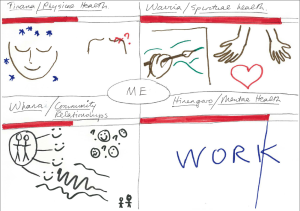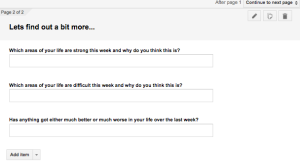Tewhare Tapa Wha – The house of wellbeing
This concept of wellbeing draws from the wisdom of our indigenous Maori. It was conceptualised by psychiatrist Mason Durie and translates as ‘the house of wellbeing’. The house is a metaphor of the self and is held up by four pillars, all of which are crucial to overall wellbeing. Here is a power point that explains the significance of the four pillars:
Over the years I have been a mental health professional, it has become a foundation of the philosophy with which I approach counselling. Serendipitously, it is also a foundation of the approach to wellbeing at Hobsonville Point Secondary School. Using this model of wellbeing allows me to work with both children and adults in ways that help them and me understand them and find ways through their struggles. There are 3 things I want to touch on to illustrate this.
1. Using Tewhare Tapa Wha as a mapping and scaling exercise. Imagining that they are looking down on the house from above, I invite people to draw four quadrants on a piece of paper and label them with each aspect of wellbeing. They then scale their current state of wellbeing in each area. Its important to make it current, a snapshot. They then use the four boxes to draw or write about the things that influenced where they placed themselves on the scale. After a while, we have a talk about what they have drawn or written.
We can see links between the different areas, for example in the one above that I did for myself today to illustrate this page, I was struck by how important to my whole sense of wellbeing it is that I am sleeping well at the moment (Tinana/Physical). Wairau/spiritual health is clearly represented by my drawing of holding a paintbrush. Artistic expression is a deeply soulful activity and makes me feel open-hearted and generous. This has a link to my generally positive feelings about work today. Things are often revealed that might not come out in the open so easily without this tool. For example another thing that struck me about my own drawing today was the hands. Spirituality for me is ‘hands on’, directly felt, not an abstract thing.
2. The other thing I find useful is the indigenous philosophy behind Tewhare Tapa Wha (as far as I understand it). When explaining these concepts to people, I always start by saying that I am drawing from an indigenous model because these ideas are unique to Maori and whether or not we are Maori ourselves, the Maori world view comes from this place underneath our own feet. I like the way this grounds the exercise right here and right now. When we experience the quadrants of wellbeing, most people can think through their current physical, mental and relational health. Spiritual health is more challenging for most people in the modern Western world, even those who belong to religions. This idea of Wairua seems to contain within it a sense of connectedness to the earth and living beings and to meaning beyond what the conscious, logical mind perceives. For me and I think many people with whom I work as a therapist, wellbeing in the Wairua quadrant helps to make sense of lives and challenges in the deepest way. I think traditional Western conceptions of mental health miss out Wairua. They are often too focussed on problems and pathologies and because of this are inadequate in helping make sense of existential issues like making meaning of the suffering that happens in all lives. (I know this is a sweeping statement to make).
3. I am developing an online Hauora screening tool to be used at HPSS. Details of this will follow.
Online Screening Tool Phase 1:
I developed this google form to be used as a simple check for wellbeing amongst students at Hobsonville Point Secondary School. Approximately once each month, each hub completes the form below. These screens are seen by the counsellor and the coach.
Google forms automatically displays the responses on a spread sheet. Here is an example:
How it is working.
As counsellor, this screen gives me a way of regularly checking on students wellbeing. Most of the time, students will say that they do not need any help, even if they indicate that some things are difficult in their lives. I find this interesting and am not sure how to interpret it. Is it a sign of resilience that they don’t feel they need help? Is it unfamiliarity with the help services that we offer here at this school? Or do young people just struggle along in their lives quite often not realising that they can get help, even if they are clearly given the option? I do not know the answers to these questions yet and further refinements to the screen may give more information.
Coaches have indicated that when they scan the responses of the students in their hubs, it is useful for them to note what students are saying. The responses can be a way to open conversation with students about things that are difficult to raise. The screen also gives coaches information that they can add to the mix of other observations they are making of students on a day to day level. Our coaches have a closer and more wide-ranging role in students lives than many teachers do in more traditional secondary schools. Because of this, they sometimes need a little mentoring about dealing with the more pastoral side of the role. Coaches also sometimes need to discuss the point at which the specialist skills of the counsellor are needed with a student.





